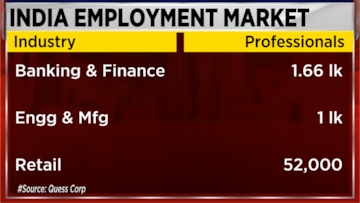Meanwhile, Ramani Dathi, CFO of TeamLease Services, highlighted an increase in hiring demand in the manufacturing, engineering, retail, e-commerce, FMCG and IT sectors.
In an interview with CNBC-TV18, Bhatia further explained that in the July 2024 budget, the government introduced employment-linked incentive programmes, mentioning “employment” 27 times and allocating ₹2 billion dollars to support these initiatives. He added that this effort aims to transition the economy from the informal to the formal sector.
These are verbatim excerpts from the interview.
Q: You all have published a report. You all have surveyed people about hiring intention. Just give me the above figures. Compared with the first half of 2023, the second half and the first half of 2024, how has the hiring trend been?
Data: Firstly, compared to last year, we are seeing a good increase in demand in sectors like manufacturing, engineering, retail, e-commerce and FMCG. And to some extent, even the FMCG sector is still facing some headwinds. We are seeing single-digit growth in those sectors. For a long period, IT headcount was declining overall for us, but now we are seeing headcount stabilising in IT and we are expecting positive growth from January 2025 onwards.
Read also: Unemployment, slow growth and more: The risks of RBI’s ‘high’ real interest rates
Also, in terms of sectors and locations, metropolises are still absorbing the largest job creation when it comes to formal jobs and the most recent hiring intention; there is a slight improvement compared to the first half of this year. There is an improvement of around 4% compared to the period from January to June, compared to the next half of this year, and also in profiles with less than five years of experience, we are seeing a good increase in demand. However, for mid-level and senior positions so far, we have seen a slight reduction in demand, but the overall outlook has been positive so far.
Q: Give us an overview first before we get to this perhaps unnecessary concern about IT. How has hiring been at Quess Corp at the end of last year, in the first two halves and this year?
Bhatia: First of all, we have to start with the big picture. India has about 1.4 billion people, and if you take into account the working age people, the population is about 890 million people, so about 890 million people are participating in the labour force, as you have also pointed out, and the Economic Survey of India reflects that we have about 57% of India’s population that is in the labour force today. There are two or three dynamics that you can see following that data. The first dynamic is that we have about 79% to 80% of the Indian population in informal employment, and only about 21% of the people are in formal or regular jobs which are supported by social security, pensions and other benefits as well. So, this gives us a disparity between low wages and high wages.

For the last 33 years, what India has been able to do effectively is to focus on the white-collar postgraduates when it comes to liberalisation. We are all beneficiaries. On this call, most of your channel members are probably the ones who have been in that cohort. What the government is trying to change now is that they are looking at the pace of the pyramid. They are looking at the blue-collar workers and the grey-collar workers. Why do I say that? Firstly, there is a transition from the informal to the formal economy. The second transition is from rural to urban India. The third is that in the last 20 years we have spent a lot on education and training. Can we do more? We should do more, but still we have spent a lot on that.
When you spend on education and training and ensure that everyone reaches the 10th or 12th grade, people don’t want informal work in the field, whether it’s like the Mahatma Gandhi National Rural Employment Guarantee Act, 2005 or MGNREGA or casual labour. They look for formal jobs, they look for jobs that support social security. So, if you look at the Quess data, the first quarter results were 3,000 short of the 600,000 mark. In the last one year, we have grown to about 61,000 net additions to employment.
However, the biggest figure is hidden in the Universal Account Number (UAN). During a year in which Quess added 61,000 net jobs, we added 166,000 people who came to Quess for the first time and got a UAN number from us. So, we are trying to tell you that many informal workers are moving to formality and the average wage here is about ₹22,000 per month.
Q: Can you repeat that number again? How many people did you organize in terms of personnel in fiscal year 2023 and then in fiscal year 2024? What is the UAN number called?
Bhatia: In fiscal year 23, there were approximately 56,000 people, and 56,000 people are a net addition. We have a gross addition, people who come to our employment, but then we have a desertion. The difference is the growth that occurs in employment. There were 56,000, they increased to 61,000 in the last fiscal year. That is the first figure. However, again, with 61,000 net additions, the figure that gives us the most satisfaction is that 166,000 people came to Quess and applied for the UAN for the first time. They could be between 18 and 24 years old.
Read also: Cabinet approves creation of 12 new industrial areas, which will generate 10 lakh direct jobs
I come back to the point that people are looking to not depend on MGNREGA. MGNREGA makes you earn only ₹2 of each ₹5 for 115 days. People are looking for formal jobs supported by social security. So, the government’s debate in this budget. And I like the fact that in the budget they have come up with incentive programmes linked to employment. Not only have they talked about employment 27 times in the budget, but they have given Rs 2 trillion to support it with what they intend to do, which is to transition the economy from informal to formal, supported by formal jobs.
To watch the full discussion, please see the attached video.
Disclaimer:
The information contained in this post is for general information purposes only. We make no representations or warranties of any kind, express or implied, about the completeness, accuracy, reliability, suitability or availability with respect to the website or the information, products, services, or related graphics contained on the post for any purpose.
We respect the intellectual property rights of content creators. If you are the owner of any material featured on our website and have concerns about its use, please contact us. We are committed to addressing any copyright issues promptly and will remove any material within 2 days of receiving a request from the rightful owner.

